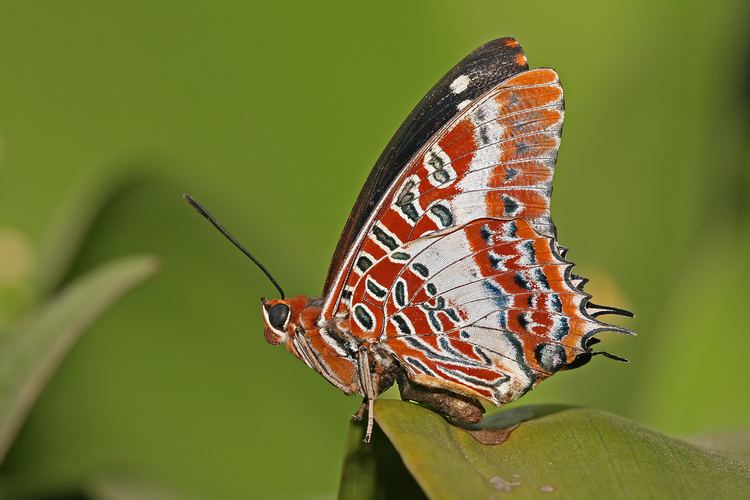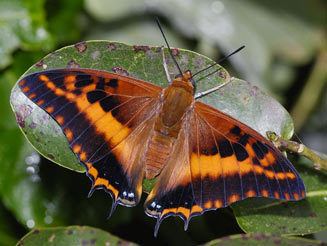Scientific name Charaxes Order Butterflies and moths | Tribe Charaxini Rank Genus | |
Lower classifications Charaxes jasius, Charaxes bernardus, Charaxes candiope, Charaxes smaragdalis, Charaxes castor | ||
Common blue charaxes puddling
The rajah and pasha butterflies, also known as emperors in Africa and Australia, (genus Charaxes) make up the huge type genus of the brush-footed butterfly subfamily Charaxinae, or leafwing butterflies. They belong to the Charaxini tribe, which also includes the nawab butterflies (Polyura). Charaxes are tropical Old World butterflies, with by far the highest diversity in sub-Saharan Africa, a smaller number from South Asia to Melanesia and Australia, and a single species (Charaxes jasius) in Europe. They are generally strong flyers and very popular among butterfly collectors.
Contents
- Common blue charaxes puddling
- The two tailed pasha charaxes jasius
- Biology
- Life history
- Description of the imago
- Sexual differences
- Taxonomy
- Species groups
- Species
- Species found in the Afrotropical ecozone
- References

The two tailed pasha charaxes jasius
Biology

Charaxes frequent sunny forest openings and glades where they rest with open or partly open wings sunning themselves. When alerted, they close the wings exposing the cryptic underside. Certain favoured perches are selected and intruders are chased and driven off, Charaxes feed in part at oozes from tree wounds infested with beetle or other larvae and on rotting fruit (they come to hanging traps baited with fermenting banana). They lay their eggs on small under-storey or marginal trees. Tender shoots are usually selected for egg laying but as the larvae grow they move to older leaves. Larvae rest on the upper surface of a leaf on which they have spun a protecting silk pad.
"The most striking features in the habits of Charaxes are the rapid flight, the partiality to putrid matter, and the constancy with which a specimen returns to the same spot. Few species are found in the open country (Ch. pelias pelias, jason, fabius), where there are only bushes and rarely trees; most species inhabit the more wooded country, and some are found only in and near larger forests. The males come often in some numbers to water pools on roads; both sexes are fond of the juice of trees, of decaying fruits, dung of animals, putrid meat, and can successfully be entrapped by the use of such baits; one is known to come to flowers (Ch.zoolina).
The larvae feed variously on Rhamnaceae, Leguminosae, Sapindaceae, Melianthaceae, Euphorbiaceae, Gramineae, Ochnaceae, Lauraceae, Tiliaceae, Meliaceae etc.
Charaxes acraeoides is part of a mimetic ring with Pseudacraea and Acraea
Life history
"We have examined the eggs of a number of species, taken from the bodies of dry specimens. Apart from size, there is no apparent difference in the eggs of the various species. The micropyle end is flattened, slightly concave, with the centre raised; from the centre radiate slight ribs, which gradually disappear at the sides and do not reach the base or underside; the longitudinal ribs are connected by extremely feeble transverse ridges, and bear, as Doherty correctly points out, small projecting points, which are easily visible under a good lens.
The slug-shaped caterpillar is widest in or before the middle, narrowed behind, and has a finely granulated skin. The head is flat, prognathous, and bears four processes which point backwards and are rough with tubercles, as is the hinder edge of the head between the processes; cheeks also tubercalated; the anal segment bears dorsally two more or less prominent processes, which are longer in the young larva than in the full-grown one. The colour of the larvae is generally green, often yellowish, the head bears, on each side, a light line which runs along the outer horn, and there is a spot on one or more abdominal segments, the colour of these latter markings, which are mostly more or less halfmoon-shaped, is as a rule buffish, the spots having often a darker (reddish or bluish) border. The caterpillar is a very slow creature, which does not voluntarily leave the twig on a leaf of which the egg was deposited.
The thick chrysalis is bright green as a rule, very smooth and shining, dorsally very convex; head bluntly bipartite; end of abdomen with two rounded tubercles ventrally."
Description of the imago
Adult Charaxes have a robust thorax and abdomen. Their wingspan is around 8 to 10 cm. The ground colours of the wing uppersides vary from tawny to black to pale. Wing markings may be spots, bars or bands of white, orange or blue. Some species have metallic blue spots and others have an overall iridescent, metallic gloss. Charaxes zingha is partially red and Charaxes eupale is light green. The males of the Charaxes etheocles complex are largely black and are known as the "black Charaxes".
The outer margin of the forewing varies from being nearly straight to deeply concave. The hindwing is abdominally always longer than costally, and in most species presents a triangular shape. The teeth on the distal (or outer) margin of both wings vary much according to species and groups of species, and is also not entirely constant within a species. The anal angle (wing corner) is in many species more pronounced than the outer margin between the tails, best seen in Charaxes zingha.
The pattern of the upperside is often very different in the sexes and in the various species. The females can be arranged according to the pattern of the upperside of the forewing into four groups:
The underside is sometimes very colourful with orange, grey and auburn silver areas.
Sexual differences
Sexual dimorphism is among Charaxes a much commoner phenomenon than similarity of the sexes in colour and shape. The wings of the female are always broader than those of the male, and the hindwing is, as a rule, less triangular; the tails are broader, often widened at the end; in some species the male has one, the female two tails, in other the tails of the male are obliterated (absent), while the female possesses such an appendage.
Taxonomy
The taxonomy is complex with very many ranks (subspecies, forma and variants) and Charaxes demonstrate both allopatric and sympatric speciation. Splitters, possibly with commercial as well as entomological interests, have named very many forms – an example is Georges Rousseau-Decelle. "No group of African butterflies arouses stronger emotions than Charaxes. Gaining an understanding of their phylogenetic relationships will add a new chapter to their convoluted literature".
Significant monographs on the taxonomy of Charaxes include:
Van Someren studied long series of museum specimens, drawing attention, as had his predecessors, to the variability of Charaxes species over their often vast range identifying and describing subspecies and isolating new species. This clinal variation is complicated by variation associated with climate (season), altitude and mimicry. Van Someren recognizes species groups, the analysis is in part subjective and the number of taxa remains uncertain.
Species groups
Defining species groups is a convenient way of subdividing well-defined genera with a large number of recognized species. Charaxes species are so arranged in assemblages called "species groups" but (not superspecies, but an informal phenetic arrangement). These may or may not be clades. As molecular phylogenetic studies continue, lineages distinct enough to warrant some formal degree of recognition become evident and new groupings are suggested, but consistent ranking remains a problem.
Species
In older literature, some of the nawab butterflies, such as Polyura dolon, may be included under Charaxes.
Species found in the Afrotropical ecozone
Listed alphabetically.
